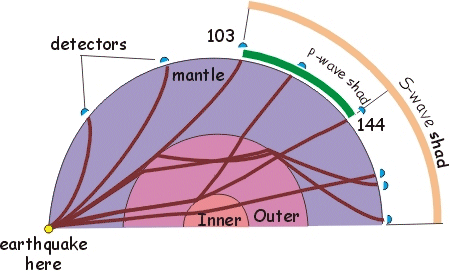 A
seismic model for the Earth based on observations of
the arrival time of seismic energy at receiver stations distibuted around
the Earth's surface. Selected raypaths are shown for seismic P-waves transmitted
through the Earth from a single earthquake source. The raypaths are curved
because of refraction through rocks whose ability to transmit seismic energy
(velocity) increases steadily with depth. The effect is to create a shadow zone
for P-waves as shown. However, rare P-waves are reflected off the inner core
to arrive in this shadow zone. Models such as this are used to build a general
uniform view of how seismic velocity varies in the Earth and are based on the
analysis of hundreds of earthquakes from many different sources (examples include
a version called PREM, the Preliminary Reference Earth Model). It averages out
lateral variations to give a classic picture of an Earth with "onion-skin"
like layering. Detailed analysis of a few earthquakes and the seismic travel
time (for P-waves or S-waves) to a few closely spaced receivers can be used
to measure small (a few %) discrepancies of local seismic velocity within small
volumes of the Earth, in comparison with the general model. This method is called
seismic tomography, the geophysical equivalent of a brain scan.
A
seismic model for the Earth based on observations of
the arrival time of seismic energy at receiver stations distibuted around
the Earth's surface. Selected raypaths are shown for seismic P-waves transmitted
through the Earth from a single earthquake source. The raypaths are curved
because of refraction through rocks whose ability to transmit seismic energy
(velocity) increases steadily with depth. The effect is to create a shadow zone
for P-waves as shown. However, rare P-waves are reflected off the inner core
to arrive in this shadow zone. Models such as this are used to build a general
uniform view of how seismic velocity varies in the Earth and are based on the
analysis of hundreds of earthquakes from many different sources (examples include
a version called PREM, the Preliminary Reference Earth Model). It averages out
lateral variations to give a classic picture of an Earth with "onion-skin"
like layering. Detailed analysis of a few earthquakes and the seismic travel
time (for P-waves or S-waves) to a few closely spaced receivers can be used
to measure small (a few %) discrepancies of local seismic velocity within small
volumes of the Earth, in comparison with the general model. This method is called
seismic tomography, the geophysical equivalent of a brain scan.
Return to inner earth structure home page

 A
seismic model for the Earth based on observations of
the arrival time of seismic energy at receiver stations distibuted around
the Earth's surface. Selected raypaths are shown for seismic P-waves transmitted
through the Earth from a single earthquake source. The raypaths are curved
because of refraction through rocks whose ability to transmit seismic energy
(velocity) increases steadily with depth. The effect is to create a shadow zone
for P-waves as shown. However, rare P-waves are reflected off the inner core
to arrive in this shadow zone. Models such as this are used to build a general
uniform view of how seismic velocity varies in the Earth and are based on the
analysis of hundreds of earthquakes from many different sources (examples include
a version called PREM, the Preliminary Reference Earth Model). It averages out
lateral variations to give a classic picture of an Earth with "onion-skin"
like layering. Detailed analysis of a few earthquakes and the seismic travel
time (for P-waves or S-waves) to a few closely spaced receivers can be used
to measure small (a few %) discrepancies of local seismic velocity within small
volumes of the Earth, in comparison with the general model. This method is called
seismic tomography, the geophysical equivalent of a brain scan.
A
seismic model for the Earth based on observations of
the arrival time of seismic energy at receiver stations distibuted around
the Earth's surface. Selected raypaths are shown for seismic P-waves transmitted
through the Earth from a single earthquake source. The raypaths are curved
because of refraction through rocks whose ability to transmit seismic energy
(velocity) increases steadily with depth. The effect is to create a shadow zone
for P-waves as shown. However, rare P-waves are reflected off the inner core
to arrive in this shadow zone. Models such as this are used to build a general
uniform view of how seismic velocity varies in the Earth and are based on the
analysis of hundreds of earthquakes from many different sources (examples include
a version called PREM, the Preliminary Reference Earth Model). It averages out
lateral variations to give a classic picture of an Earth with "onion-skin"
like layering. Detailed analysis of a few earthquakes and the seismic travel
time (for P-waves or S-waves) to a few closely spaced receivers can be used
to measure small (a few %) discrepancies of local seismic velocity within small
volumes of the Earth, in comparison with the general model. This method is called
seismic tomography, the geophysical equivalent of a brain scan.